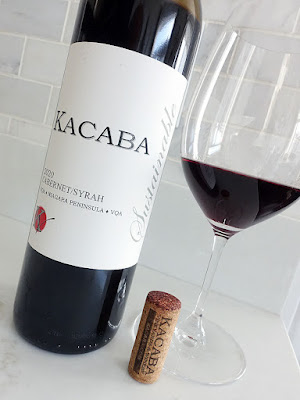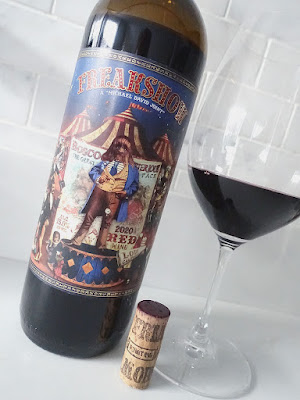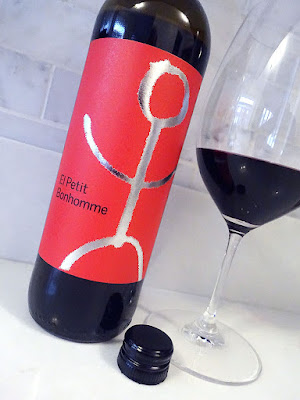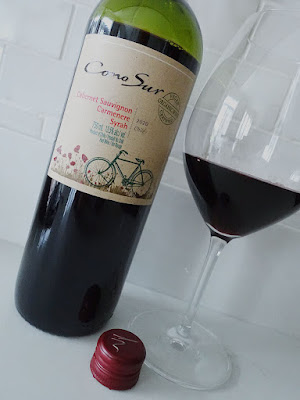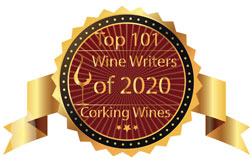red wine review is a lovely Syrah-based blend from Languedoc that newly arrived at the LCBO last weekend in the LCBO VINTAGES New Release Collection. It is included as part of the release's theme on Perfect Pairings for Spring Celebrations and will be a fine match for backyard BBQs.
It is produced by Cave de Roquebrun, a co-operative winery located in the Languedoc wine region of France. It was founded in 1967 in Haut-Languedoc Natural Regional Park, approximately 30 km north of Béziers, between Montpellier and Toulouse. More specifically, it is situated in the picturesque village of Roquebrun, which lies within the Saint-Chinian appellation of the Languedoc-Roussillon wine region, and offers an exceptional, sunny microclimate for Mediterranean vegetation and the cultivation of fruit. Moreover, Cave de Roquebrun is located on schist terroir, which is typical of Languedoc, and allows Roquebrun to produce original and high-quality wines.
Today, Cave de Roquebrun is the largest wine producer within the Saint-Chinian appellation, consisting of 70 winegrowers who cultivate over 700 hectares of vines. With a team of professionals motivated by high standards, their philosophy is to create wines of originality, balance, and wealth.
In order to realize their philosophy, their schist terroir plays a very important role. The climate in Roquebrun is very mild and relatively arid, and when combined with schist soils, the development of the different grape varieties is very special and unique. The soils where the vines are planted are among the oldest in France, dating back to the Devonian, Ordovician, and Visean eras, which are more than 330 million years old. Schists are a brown, green, or sometimes red rock, with a flaky appearance that is fine-grained and includes tiny fragments of other minerals. These rocks are laminated and fragmented, allowing the roots of the vine to go deep into the ground in the search for naturally circulating rainwater. This mineral has two main virtues: it retains water, while also storing heat which is released slowly at night and, according to local winegrowers, allows the grapes to still grow at night.
This red wine is a blend of 65% Syrah, 20% Grenache, and 10% Mourvèdre that was grown on the clay-limestone slopes on the banks of the Orb River. The grapes were manually harvested at night to retain freshness, and upon arriving at the winery they were direct-pressed, cold settled, and underwent a long fermentation at a low temperature. To retain the full expression of the fruit, the wine was matured in stainless steel vats for at least a year in an insulated and air-conditioned cellar.
Despite spring frosts and summer hail which created uncertainty among growers, the 2022 vintage in Languedoc is said to be the best since 2011. While extreme weather patterns have become commonplace in the Languedoc region of France, summer brought sunshine and wind, reducing the risk of disease, while some grape varieties progressed rapidly. Timely rains in mid-August and at the beginning of September helped polish the tannins and polyphenols. From then on, the weather was idyllic, allowing producers to pick grapes at peak ripeness without any concern. Let's see how this 2022 Languedoc red is tasting tonight...
This unoaked blend of 65% Syrah, 20% Grenache, and 10% Mourvèdre has a fresh, lifted nose of medium-high intensity that offers generous and attractive aromas of ripe red & black fruits, blackberry, black cherry, raspberry, and black plum that mingles with earthy and stony minerality, plus touches of wild herbs. It's mid-weighted on the dry and very ripe palate with delicious flavours of wild berry, garrigue, blackberry, raspberry, peppery spice, stony mineral, and savoury earth. It has fresh acidity and supple, chalky textured, gently grippy, and well-structured tannins. Smoky mineral notes linger on the long, crisp, and well-structured finish. Highly recommended buy! Score: 89 pts
A wine by Cave de Roquebrun will be available at the LCBO in a couple of weeks, while the entire can be ordered today through their Agent - Eurovintage Wines & Spirits.
It is produced by Cave de Roquebrun, a co-operative winery located in the Languedoc wine region of France. It was founded in 1967 in Haut-Languedoc Natural Regional Park, approximately 30 km north of Béziers, between Montpellier and Toulouse. More specifically, it is situated in the picturesque village of Roquebrun, which lies within the Saint-Chinian appellation of the Languedoc-Roussillon wine region, and offers an exceptional, sunny microclimate for Mediterranean vegetation and the cultivation of fruit. Moreover, Cave de Roquebrun is located on schist terroir, which is typical of Languedoc, and allows Roquebrun to produce original and high-quality wines.
Today, Cave de Roquebrun is the largest wine producer within the Saint-Chinian appellation, consisting of 70 winegrowers who cultivate over 700 hectares of vines. With a team of professionals motivated by high standards, their philosophy is to create wines of originality, balance, and wealth.
In order to realize their philosophy, their schist terroir plays a very important role. The climate in Roquebrun is very mild and relatively arid, and when combined with schist soils, the development of the different grape varieties is very special and unique. The soils where the vines are planted are among the oldest in France, dating back to the Devonian, Ordovician, and Visean eras, which are more than 330 million years old. Schists are a brown, green, or sometimes red rock, with a flaky appearance that is fine-grained and includes tiny fragments of other minerals. These rocks are laminated and fragmented, allowing the roots of the vine to go deep into the ground in the search for naturally circulating rainwater. This mineral has two main virtues: it retains water, while also storing heat which is released slowly at night and, according to local winegrowers, allows the grapes to still grow at night.
This red wine is a blend of 65% Syrah, 20% Grenache, and 10% Mourvèdre that was grown on the clay-limestone slopes on the banks of the Orb River. The grapes were manually harvested at night to retain freshness, and upon arriving at the winery they were direct-pressed, cold settled, and underwent a long fermentation at a low temperature. To retain the full expression of the fruit, the wine was matured in stainless steel vats for at least a year in an insulated and air-conditioned cellar.
Despite spring frosts and summer hail which created uncertainty among growers, the 2022 vintage in Languedoc is said to be the best since 2011. While extreme weather patterns have become commonplace in the Languedoc region of France, summer brought sunshine and wind, reducing the risk of disease, while some grape varieties progressed rapidly. Timely rains in mid-August and at the beginning of September helped polish the tannins and polyphenols. From then on, the weather was idyllic, allowing producers to pick grapes at peak ripeness without any concern. Let's see how this 2022 Languedoc red is tasting tonight...
Tasting Note:
CAVE DE ROQUEBRUN SOLEIL DE SCHISTE 2022 - AP, Languedoc, France (#35995) (XD) - $18.95This unoaked blend of 65% Syrah, 20% Grenache, and 10% Mourvèdre has a fresh, lifted nose of medium-high intensity that offers generous and attractive aromas of ripe red & black fruits, blackberry, black cherry, raspberry, and black plum that mingles with earthy and stony minerality, plus touches of wild herbs. It's mid-weighted on the dry and very ripe palate with delicious flavours of wild berry, garrigue, blackberry, raspberry, peppery spice, stony mineral, and savoury earth. It has fresh acidity and supple, chalky textured, gently grippy, and well-structured tannins. Smoky mineral notes linger on the long, crisp, and well-structured finish. Highly recommended buy! Score: 89 pts
A wine by Cave de Roquebrun will be available at the LCBO in a couple of weeks, while the entire can be ordered today through their Agent - Eurovintage Wines & Spirits.



